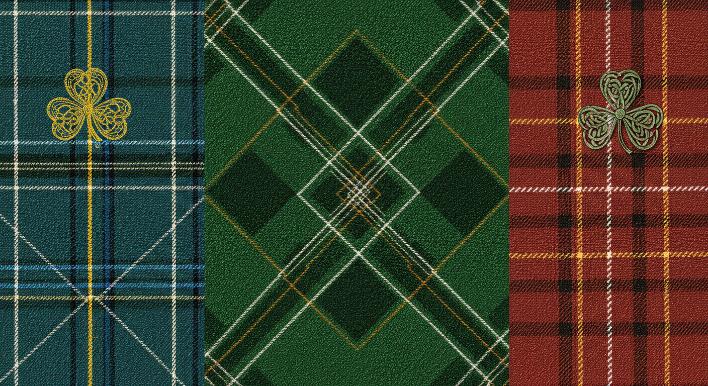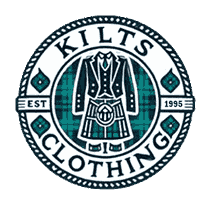Understanding the Tartan: Decoding the Symbolism of Irish Kilt Patterns

The Irish kilt is a timeless symbol of Irish heritage, but what truly brings this iconic garment to life are the tartan patterns that adorn it. Tartan, with its distinctive woven design, has a rich and layered history that stretches back to ancient times. While many people associate tartan with Scotland, Ireland, too, has a deep connection to these intricate patterns. Each tartan design is more than just an aesthetic choice—it's a visual language that speaks volumes about family heritage, regional identity, and cultural pride.
In this blog, we will explore the symbolism behind Irish tartan patterns, the history of their evolution, and how these designs continue to influence modern-day fashion. Let's dive into the story of how a simple pattern on fabric became a symbol of national pride and identity for the Irish people.
What is Tartan? A Brief Overview
Tartan is a type of fabric woven from dyed wool that features a repeating pattern of stripes in both horizontal and vertical directions. The pattern forms a grid-like design, often referred to as a "check" or "plaid," and the colors and arrangements within that grid hold specific meanings. While the most famous examples of tartan are in Scottish kilts, The ancient Celts, who inhabited much of Ireland and Britain, also practiced the tradition of tartan weaving.
In the context of Irish kilt, tartan patterns are not just decorative; they reflect deeper cultural meanings. The colors, weaves, and even the fabric choices used in Irish tartans tell a unique story about the person or community wearing it. Tartan designs can signify a person's clan, family, or even regional origins, each pattern carrying with it a sense of belonging and identity.
The History of Irish Tartan: From Ancient Times to Modern Usage
The story of Irish tartan begins in the ancient Celtic world. The Celts, who lived across Ireland and Scotland, were skilled weavers, and they started creating patterned fabrics as early as the 3rd century BCE. These early designs were simple, with horizontal and vertical stripes made from natural plant dyes. The wool created garments that were durable and practical for the harsh climates of the region.
However, the use of tartan as we know it today didn't gain its iconic status until much later. For much of Irish history, tartan patterns were not as standardized as in Scotland, where the modern-day tartans became a symbol of clan identity. Irish tartans were more regionally based, and the variations in patterns often reflected local customs, resources, and the natural environment.
During the 19th century, there was a resurgence of interest in Irish heritage and culture. As part of the Irish Cultural Revival, traditional garments like the irish traditional kilt and their distinctive tartan patterns were rediscovered and celebrated. Today, Irish tartan is a proud reminder of the country's history. It continues to be a significant part of national pride.
The Significance of Tartan Patterns: More Than Just Fabric
While tartan patterns are undeniably beautiful, their significance runs much more profound. Each tartan design is a powerful symbol. In both Irish and Scottish cultures, specific colors and patterns were often used to represent the wearer's clan or family. In Ireland, the use of tartan by the regional and familial identities is much like the Scottish clan system.
The colors in a tartan can also carry meaning. Green, often seen in Irish tartans, is a symbol of the country's lush landscapes and agricultural heritage. Red, on the other hand, has historically represented bravery and strength, a sentiment tied to Irish warriors and their battles for independence. Sometimes, Yellow and gold represent wealth and prosperity, though they are less common in traditional Irish tartans.
Some tartans reflect not just family or clan identity but also the wearer's connection to the land. The natural dyes used in these fabrics were derived from the local flora and fauna, meaning that the colors of a particular tartan might reflect the area from which the wearer came. These connections to the land are part of what makes Irish tartans so unique.
Regional Differences: How Geography Influences Tartan Designs
One of the most fascinating aspects of Irish tartan is how its patterns reflect regional influences. In Ireland, tartans were not just worn to indicate family affiliation. Still, they were often specific to particular provinces or even smaller geographic areas. Each region has a link to its own set of patterns to the natural surroundings, the local culture, and the way of life.
For example, tartans from Ulster, one of Ireland's provinces, often incorporated earthy tones, reflecting the rich, green landscapes and agricultural heritage of the region. Tartan from Connacht, another Irish province, might feature more vibrant colors that echoed the rugged terrain and wild beauty of the area. These regional distinctions not only served to identify where the wearer came from but also to honor the landscape that shaped their life and culture.
As Irish tartan became more standardized in the modern era, these regional variations were often combined or simplified. Still, the connection between geography and pattern remains a strong element of Irish tartan design.
Irish vs. Scottish Tartan: Key Differences
While tartan is often associated with Scottish kilts, Irish kilts for men hold their unique place in history. Both Ireland and Scotland share Celtic roots, and their tartan traditions are intertwined. However, there are some key differences between the two.
Scottish tartans are perhaps the most recognizable worldwide, primarily due to the use of distinctive clan tartans that are now iconic in Scottish culture. Each Scottish clan has its unique tartan, and the design of the pattern is tied to the family's heritage, often including specific colors that represent particular qualities or origins.
Irish tartans, in contrast, are more regional. While some Irish families have their tartans, they are not as widely standardized or as strictly regulated as their Scottish counterparts. The Irish tradition tends to focus more on the general color palette and patterns that reflect broader Irish heritage rather than being specific to individual families.
Despite these differences, both Irish and Scottish tartans share a common thread in the use of weaving patterns to signify identity, pride, and heritage. Both cultures continue to use tartan designs in kilts, fashion, and other garments to celebrate their unique history.
How to Read Tartan: Understanding the Weave and Color Combinations
Tartan patterns may look complex at first glance. Still, once you understand how to read them, they reveal a great deal about the wearer's identity and history. Made with crisscrossing horizontal and vertical threads, these tartans are in different colors. The vertical threads, known as the warp, run up and down, while the horizontal threads, known as the weft, run across.
The design is typically made by alternating colored stripes to form blocks of color, often in repeating sequences. The size and arrangement of the stripes create different tartan patterns. The more lines and colors there are, the more complex the tartan will appear.
The specific combination of colors and lines determines the identity of the wearer. For example, in Irish kilts, the inclusion of green might signify Irish pride or a connection to the land. At the same time, red could stand for the strength of the Irish people. Each combination of colors and patterns tells a story.
Modern-Day Tartan: From Traditional to Contemporary Fashion
While the traditional Irish kilt remains a staple for formal occasions, modern fashion has embraced tartan in a variety of creative ways. Today, tartan patterns are used not just for kilts but also in shirts, scarves, ties, and even casual clothing. Designers often take inspiration from classic tartan patterns, creating new versions with updated color combinations or materials.
The contemporary embrace of tartan allows people to wear their heritage in a more subtle and everyday way. Whether it's through a classic kilt at a wedding or a tartan scarf on a chilly afternoon, the pattern remains a vibrant part of Irish culture.
Conclusion: A Pattern of Tradition and Identity
Tartan patterns go beyond decoration—they weave deeply into the fabric of Irish history and culture. Each thread tells a story of region, family, and heritage, creating a lasting connection between the past and the present. Whether worn during traditional ceremonies or as part of modern fashion, the Irish tartan is a proud symbol of national identity and cultural pride.
As Irish tartans continue to evolve, their symbolism remains as strong as ever. They are a visual celebration of Ireland's history, its people, and the landscapes that have shaped their identity for centuries.


